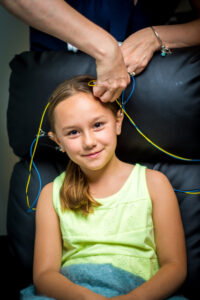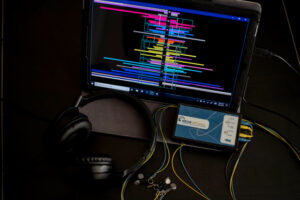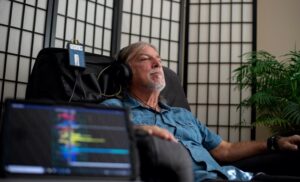Have you ever been in training? You train your body to run a race, play a sport, or strengthen your muscles. Neurofeedback training is training for your brain.
Neurofeedback is a type of biofeedback. During biofeedback, you’re connected to electrical pads that help you get information about your body. In the case of neurofeedback, it explains how brains work by measuring and transmitting signals to a person. The signals are the feedback. The type of feedback can vary from sounds to silences depending on the training used.
Training increases your ability and improves your skills. Military members train to maintain and improve the skills needed for their jobs. This way, in a real-life scenario they will be able to respond.
Teachers train to learn new techniques. They learn about new research and teaching methods and how to use new technology.



You train your body when you play sports, lift weights, or do yoga. It keeps your body fit. It also has other benefits. These include better balance, bone strength, heart health, and lower depression risks.
Neurofeedback trains the brain for efficiency and sharpness. The brain controls thought, memory, and emotion. It also controls motor skills, vision, and breathing, as well as hunger, and all body processes. Neurofeedback promotes optimal brain function.
What is Neurofeedback?
“Neurofeedback is a kind of biofeedback, which teaches self-control of brain functions to subjects by measuring brain waves and providing a feedback signal.”( Marzbani H, Marateb HR, & Mansourian M. 2016)
Think of it like this: our brains make electrical signals. This is much like how a radio emits waves. A tool called an electroencephalograph (EEG) measures these signals. They reflect our current mental state. Biofeedback provides a signal to the brain.
Neurofeedback has its foundation in the field of neuroscience. In the 1960s, after the discovery of the EEG, a field of research began. The research focused on using neurofeedback as a treatment for various disorders. The treatment used positive or negative feedback for a desired outcome. Today there are different types of neurofeedback.
NeurOptimal® Neurofeedback System

At Freedom Neurofeedback we use the NeurOptimal® Neurofeedback system. NeurOptimal® utilizes a specific type of neurofeedback called Low-Energy Neurofeedback (LEN). It does not rely on a specific diagnosis to be used, which means that everyone can benefit from its training.
During a NeurOptimal® session, you wear ear clips and two small sensors on the sides of your head. There is a small device that is an amplifier (z-amp) for the sensors. It converts the analog signal from the sensors into a digital signal for the computer. The laptop has software that receives information and detects changes. It then presents the information back to the brain in real time. This information or biofeedback is short breaks or pauses in the music that you hear.
NeurOptimal® communicates directly with your brain. There is nothing to interfere with that. No outside person has to evaluate you and decide what training you need. You do not need a specific diagnosis to be able to benefit from NeurOptimal® Neurofeedback. Your brain is training itself to self-correct when given information at the right moment.
A simplified example of how it works.
- Neuroptimal® doesn’t target specific frequencies. Instead, it tracks the brain’s total electrical activity. It finds small deviations from the individual’s baseline.
- Dynamic Feedback: When these deviations happen, the training pauses. The audio pauses. This interruption is the feedback. It prompts the brain to self-correct and return to balance.
Here is an analogy from the NeurOptimal® website. It explains what happens during a neurofeedback session with their machine. “Imagine you’re walking along a path on a cliffside, in the dark. You’d be floundering. But then a flashlight is shone showing the cliff edge. The flashlight doesn’t tell you what to do. But, now you can use the extra information you have (the location of the cliff edge) to walk along your path”. In this example, the flashlight interrupts. It is the feedback that reminds the brain to self-correct.
What happens during Neurofeedback Sessions?
The NeurOptimal® equipment used for the neurofeedback sessions is fully automated and comes programmed with the most up-to-date software. It does not require specialized expertise to operate. The equipment is portable so sessions can be done in our office or you can do neurofeedback at home. You have the option to rent or buy the equipment to train with NeurOptimal® at home.
Here is what the equipment looks like

Let’s look at a breakdown of what happens during the training process:
- A neurofeedback machine sees brain activity.
- Sensors: Electrodes go on the scalp, like those used in an EEG.
- Brainwave Measurement: These sensors read the electrical signals produced by the brain.
- Computer software reads these signals and detects any changes in electrical activity in the brain. It presents this back to the brain in real-time.
How Does the Training Happen

During the session, you will hear a music track. Throughout the session, you will hear breaks and pauses that won’t mean much to you but these are how NeurOptimal® tells your brain to self-optimize.
The training sessions are non-invasive and can be done while doing a quiet activity, working, homework, and some people even fall asleep during their session. This is okay because the training is equally effective no matter what you are doing. The software responds to your unique brain activity.
Neurofeedback Brain Training Promotes:
- Healthy sleep habits
- More Calm
- More Focus
- Better coping
- A healthy lifestyle
- Relaxation and stress management
- Brain fitness
- Mental fitness
Disclaimer:
This blog only provides information and is not medical advice.
Marzbani H, Marateb HR, Mansourian M. Neurofeedback: A Comprehensive Review on System Design, Methodology and Clinical Applications. Basic Clin Neurosci. 2016 Apr;7(2):143-58. doi: 10.15412/J.BCN.03070208. PMID: 27303609; PMCID: PMC4892319.



1 comment